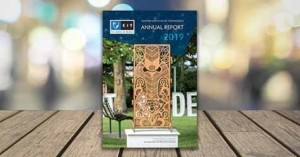EIT has released its Annual Report for 2019, highlighting a year of growth and all-round excellence. 2019 was EIT’s last full year as a separate Tertiary Education Institute, on 1 April 2020 the institute became a subsidiary company of the new Tertiary Education Institute to oversight the sixteen polytechnics, New Zealand Institute of Skills and Technology.
“Pleasingly, EIT had another very strong year performing with distinction across multiple fronts. This, at a time where many other institutes have been struggling, and the reform of vocational education caused some uncertainty amongst the sector,” says EIT Acting Chief Executive, Bill Kimberley.
In 2019, EIT registered the highest number of students in its history with 4,957 equivalent full-time students (EFTS) and 10,817 individual students in total (up 492 from 2018). International student number also continued to grow. In 2019, 1,462 students from 45 countries studied at EIT (an EFTS increase of 15 percent).
The report features strong educational performance with a 94 percent student programme satisfaction rate and 85 percent course completion rate at Level 4 and above. The total number of 2019 graduates was 4,104, exceeding the record number of 2018 (3,604).
The report showcases the extensive network of delivery through regional learning centres, on working farms, in marae and in community centres, reaching into remote corners of our regions. This represents nearly 20 percent of EIT’s delivery with more than 800 EFTS in programmes delivered outside main campuses.
Alongside growth in student numbers, EIT is financially sound and reported once again a net surplus. Mr Kimberley noted that in 45 years EIT has never made a loss.
The report also documents the support EIT’s staff offer to Māori, Pasifika and under 25-year-olds, including NEET youth (not in education, employment, or training). In 2019, 46 percent of EIT’s domestic equivalent full-time students in Hawke’s Bay were Māori, and in Tairāwhiti 78 percent, one of the highest levels of Māori participation in the tertiary education sector. 46 percent of EIT’s graduates (and one third of degree graduates) were Māori.
The report highlights EIT’s substantial growth in research capability and activity. The 2019 performance-based research fund (PBRF) round awarded 39 EIT researchers a national ranking for their research excellence. This was an increase of 22 percent compared to the last evaluation in 2012. Among the ITPs, EIT ranked second for the number of active researchers relative to number of students enrolled in courses at degree level and higher.
EIT’s strong links with local industry are profiled. In 2019 more students were offered work placements, internships and opportunities to learn “outside the classroom”. At the same time the active collaboration between EIT, business, community and industry helped in developing an array of new programmes and pathways. NZQA panels approved over 20 new programmes (including two Degrees, two Masters and six Postgraduate programmes) and nine training schemes.
The report also traces EIT’s vibrant and rich history back to 1975, when the Hawke’s Bay Community College first opened its doors for vocational and community education. In 1986, the name changed to Hawke’s Bay Polytechnic and then in 1996 to Eastern Institute of Technology. In 2011, EIT merged with the Tairāwhiti Polytechnic.
We also want to acknowledge Tim Whaitiri Henderson whose outstanding artwork “Papatūānuku” is featured on the cover of the report. It was displayed at the Art & Design Exhibition at the IDEAschool Arts Festival 2019.
“Throughout its history EIT has through its staff maintained a strong commitment to student success and all-round excellence and is recognised as one of New Zealand’s high performing tertiary education institutes,” stresses Mr Kimberley.
Check out the 2019 Annual Report here.

